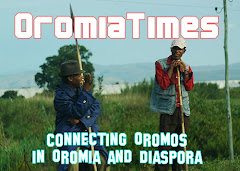February 17, 2006
latimes.com : World News
Hungry Ethiopia Finds an Answer at Its Feet
The drought-resistant wild enset plant yields food that can be preserved for decades. Now experts and aid groups are taking notice.By Edmund Sanders, Times Staff Writer
WELKITE, Ethiopia — Even as drought and starvation threaten millions of Ethiopians, farmers in this southern province say they aren't worried about hunger, thanks to an ancient but little understood agricultural weapon that experts say could one day play a role in alleviating African famines.Clustered around nearly every mud-walled hut in these highlands are the tall, big-leafed stalks of enset trees, also known as false banana, which grow wild in eastern and southern Africa but are believed to be harvested only in Ethiopia.
The power of the plant lies in its drought-resistant leaves and corm, which, when pulverized, yields a white, cheese-like substance that can be cooked into a flat bread or stored in underground fermentation pits for up to 20 years."It's always there to feed my family," said farmer Meded Kemal, 35.He recalled a drought five years ago that wiped out his small fields of maize, chickpeas, sorghum and teff, the most popular Ethiopian grain. Only the enset survived.Even after the family exhausted its underground supply, it didn't go hungry. It simply knocked down a few more enset stalks, which, unlike other crops, can be harvested any time of year."One plant can feed the family for a week," said farmer Tedesa Habte, 45, dwarfed by a field of 300 of the plants, which grow as tall as 30 feet. "We never go hungry."Nearly 15 million people in southern Ethiopia, including the Gurage, Sidama and Hadiya tribes, rely on enset for most of their nutrition, though the plant is relatively low in protein and can taste bitter. The stalks take seven years to reach maturity and harvesting is tricky. But handled properly, the plants, dubbed "the shield" by farmers, can help save lives, as they did for many of the southern tribes during Ethiopia's severe famines of 1973 and 1984.Enset harvesting is thought to date back thousands of years, but only lately has the plant drawn increased attention from agricultural experts and aid groups looking for long-term solutions to Ethiopia's drought and hunger problem. "I'm so excited about this plant," said Yihenew Zewdie, an Ethiopian food security expert for the United Nations' World Food Program. "It could be an answer to hunger. But it's not been given the attention it deserves." Enset research and development has largely been overshadowed by the focus on the more traditional grains, such as maize, that are favored by Western aid groups and relief organizations.The Ethiopian government recognized enset as a national crop nearly a decade ago, theoretically clearing the way for state-funded research and assistance. But the Agriculture Ministry remains more interested in boosting production and export of cash crops such as coffee and flowers, which have the potential to boost government coffers. The Washington-based American Assn. for the Advancement of Science, which attempted to bring attention to enset in a 1997 report, called it the "most unstudied domesticated crop in Africa" and criticized policymakers for failing to see the plant's "famine buffer potential."Several privately funded agricultural groups, including Farm Africa, have launched pilot projects to teach farmers in other parts of Ethiopia about the benefits of enset. Despite a promising reception, most of the projects have stalled for lack of funds, Zewdie said.Ethiopian Prime Minister Meles Zenawi called enset an important crop, but said research had been hindered by the fact that the plant is still commonly harvested only in Ethiopia, meaning local researchers can't benefit from the experience of other countries."Our research is limited by what we can do here, and our research capability is limited," he said.Though Western governments and humanitarian groups have provided generous emergency food aid to Ethiopia for years, Meles said, there has been less support for research and development projects to tackle the root of the country's drought and hunger problems, such as the need for new irrigation systems.His government is the latest to struggle with Ethiopia's chronic food shortages."People here are always on the precipice," said Paulette Jones, World Food Program spokeswoman in Addis Ababa, the capital.
Subscribe to:
Post Comments (Atom)

















No comments:
Post a Comment